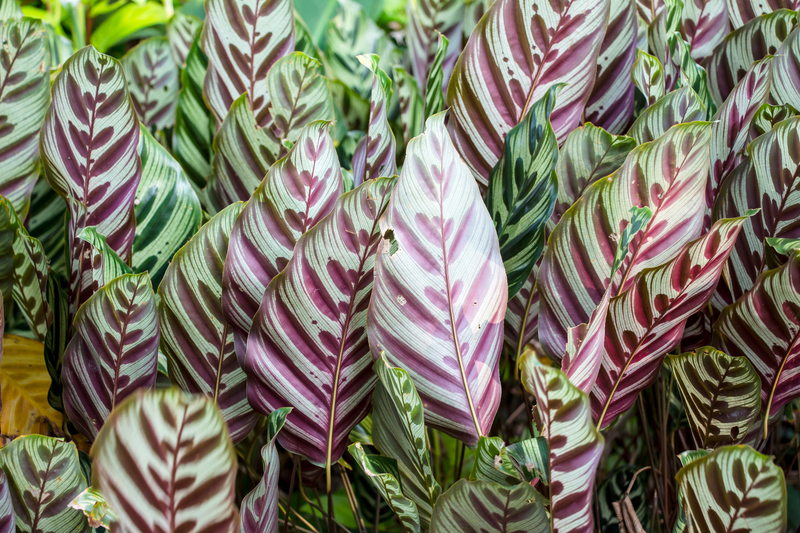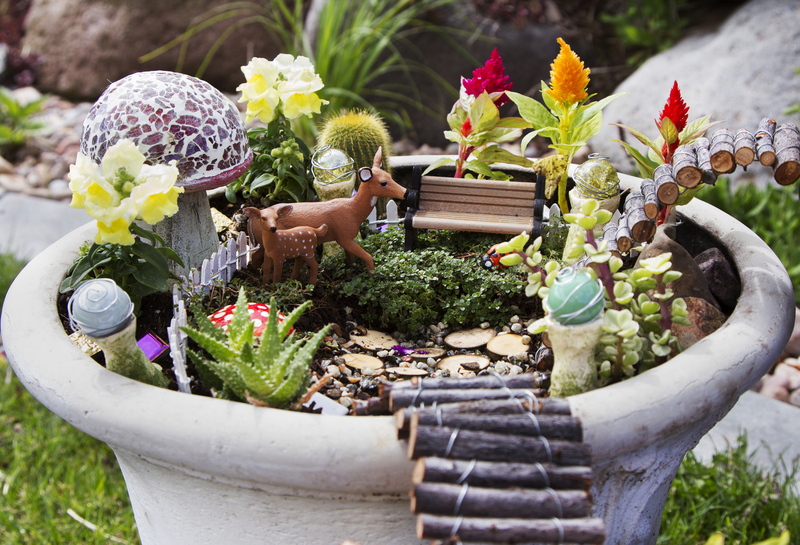Learn how your garden can become a carbon sink
Posted on 11/09/2025
Learn How Your Garden Can Become a Carbon Sink: A Comprehensive Guide
Did you know your very own backyard garden can play an essential role in fighting climate change? By transforming your green spaces into effective carbon sinks, you can contribute to capturing and storing atmospheric carbon dioxide. This in-depth article explores how your garden can become a carbon sink, providing actionable tips, scientific insights, and creative inspiration to help you maximize your garden's ability to sequester carbon.
Understanding Carbon Sinks and Their Importance
What Is a Carbon Sink?
A carbon sink is any system that absorbs more carbon than it releases. In nature,
carbon sinks include forests, oceans, and soil. Plants pull carbon dioxide (CO2) from the atmosphere through photosynthesis and store it in their structures and the surrounding soil.
By optimizing your garden, you can transform it into an efficient carbon sink, helping to offset emissions from daily life.
Why Do We Need Carbon Sinks?
- Climate change mitigation: Carbon sinks help reduce the concentration of greenhouse gases in the atmosphere.
- Soil improvement: Managing your garden for carbon sequestration improves soil health and fertility.
- Biodiversity support: The practices that sequester carbon also create habitats for beneficial insects, birds, and microbes.
- Resilience: Carbon-rich soil helps gardens withstand droughts and floods.

How Your Garden Captures and Stores Carbon
Your garden can become a powerful carbon sink by utilizing natural processes. Here's how:
- Photosynthesis: Plants absorb CO2 and convert it into carbohydrates, which becomes part of their roots, stems, and leaves.
- Soil Organic Matter: Some of that carbon is transferred to the soil when plants shed leaves or die back, and through root exudates (compounds roots secrete).
- Soil Microorganisms: Fungi, bacteria, and other life break down plant residues, increasing soil carbon.
By managing your garden to increase plant biomass and organic matter, you actively enhance its role as a carbon sink.
Key Practices to Turn Your Garden into a Carbon Sink
Ready to transform your home garden into a carbon sink? Here are specific strategies, backed by science, to maximize carbon capture and storage in your garden:
1. Grow More Perennial Plants
Perennials--plants that live for multiple years--usually have deeper, more extensive root systems than annuals. Their roots store more carbon underground, where it's more stable and less likely to escape back to the atmosphere.
- Plant shrubs and trees: Trees are among the most efficient backyard carbon sinks. Consider fruit trees, native species, or ornamental trees.
- Use ornamental grasses: Switchgrass, bluestem, and other perennials are excellent carbon storers.
- Choose perennial flowers: Coneflowers, black-eyed Susans, and lavender not only boost biodiversity but also support soil carbon.
2. Maximize Plant Biomass and Diversity
The more plants you grow--and the more types you provide--the greater the carbon capture. Diversity also promotes healthier, more resilient ecosystems.
- Layer vegetation: Combine groundcovers, shrubs, and tall trees to increase total leaf area and enhance carbon sequestration.
- Succession planting: As soon as one crop is harvested, plant another. Avoid leaving soil bare, which results in carbon loss.
- Integrate edible landscapes: Grow fruits, veggies, herbs, and nuts, which provide food and build carbon at once.
3. Foster Healthy, Carbon-Rich Soil
Your garden's soil can store more carbon than the plants themselves! Keeping soil healthy and covered is crucial to stable carbon storage.
- Add organic matter: Regularly apply compost, leaf mulch, or well-rotted manure. This feeds soil microbes, builds humus, and locks away carbon.
- Practice no-dig or minimal tillage: Disturbing soil releases carbon dioxide. Instead, layer new materials on top and let worms mix the soil organically.
- Grow cover crops: Plants like clover, vetch, or rye not only protect soil but also fix nitrogen and increase organic matter.
- Mulch: Keep soil cool, moist, and covered year-round to safeguard underground carbon stores.
Healthy soil is the foundation of every carbon-sequestering garden.
4. Avoid Chemical Inputs and Synthetic Fertilizers
Chemical fertilizers can accelerate the breakdown of organic matter, leading to soil carbon loss. Pesticides and herbicides also harm beneficial microbes necessary for soil health and carbon cycling.
- Favor organic fertilizers: Use compost, worm castings, bone meal, and seaweed-based products.
- Encourage natural pest control: Attract beneficial insects, birds, and bats by planting a wide diversity of flowers and providing water and shelter.
- Reduce use of synthetic products: Over time, reduce reliance on chemical amendments as the soil ecosystem strengthens.
5. Compost Everything You Can
Composting is an easy and effective method to increase organic matter and soil carbon on site, turning kitchen scraps and yard waste from methane-producing landfill material into rich, carbon-storing humus.
- Compost kitchen waste: Fruit and vegetable peels, eggshells, coffee grounds are perfect for home composting.
- Include garden debris: Leaves, pulled weeds, grass clippings, and pruned branches add both carbon and nutrients.
- Maintain a healthy compost pile: Alternate green (nitrogen-rich) and brown (carbon-rich) materials for efficient decomposition.
6. Switch to Eco-Friendly Landscaping Techniques
Traditional landscaping can be high in carbon emissions due to mowing, leaf blowers, fertilizers, and irrigation. By reducing your garden's carbon footprint and focusing on carbon capture, you increase its net positive impact.
- Use manual or electric tools: Limit the use of gas-powered mowers and trimmers, or replace them with battery or hand tools.
- Plant lawn alternatives: Low-mow grasses, groundcovers, or meadows require less maintenance and store more carbon.
- Practice water-wise gardening: Mulch helps retain moisture, and drought-tolerant plants minimize the need for irrigation.
Maximizing Carbon Storage in Small Gardens and Urban Spaces
No matter the size of your green space, you can maximize its potential as a carbon-sequestering garden. Small spaces may require creative solutions, but every effort counts!
- Vertical gardening: Grow vines and climbers on trellises to increase biomass in minimal ground area.
- Container gardening: Deep pots with perennials or dwarf trees still store carbon, especially when filled with compost-rich soil.
- Green roofs and walls: Install living roofs or wall planters to add greenery and carbon capture to buildings.
- Community gardens: Participate in or organize shared green spaces in your neighborhood for a collective impact.
Understanding the Science: How Much Carbon Can Gardens Store?
Research shows that home gardens and urban green spaces can sequester as much as 2-5 tons of CO2 per hectare per year, depending on local climate, soil, and management. While one backyard may only have a modest effect, millions of gardens worldwide add up fast!
- Trees: Mature trees can capture 20-50 kg of CO2 per year each, depending on species and climate.
- Soil: Organic-rich, undisturbed soil can lock up hundreds of kilograms of carbon per square meter over time.
By practicing regenerative gardening, you magnify your garden's role as a practical, local solution to global carbon issues.
Additional Benefits of Carbon Sink Gardening
Your garden offers even more than climate mitigation! These added benefits show how carbon sink gardening produces a cascade of positive effects:
- Enhanced food security: Homegrown food means fewer emissions from transport and storage.
- Improved air and water quality: Plants filter air pollutants and reduce runoff, protecting rivers and groundwater.
- Habitat for pollinators and wildlife: A biodiverse garden supports bees, butterflies, songbirds, and other creatures vital to healthy ecosystems.
- Well-being for people: Gardeners enjoy physical activity, reduced stress, and a deeper connection to nature.
Potential Challenges and How to Overcome Them
It's important to recognize and plan for common obstacles in creating a carbon-sequestering garden:
- Lack of space: Opt for intensive planting, containers, or vertical gardens to maximize your carbon sink opportunities.
- Pests and diseases: Rotate crops, use mixed plantings, and encourage beneficial wildlife. Avoid chemicals that disrupt soil processes.
- Poor soil: Start by adding compost and mulching generously while reducing tillage.
- Access to resources: Seek out community gardens or work with neighbors to share seeds, compost, and tools for collective impact.
Future-Proofing Your Garden's Carbon Storage
Because climate is changing, it's essential to future-proof your carbon sink garden:
- Diversify plantings: Mix species from different families and climate tolerances.
- Choose drought- or flood-tolerant varieties: Consult local nurseries for plants adapted to your region's changing weather.
- Create microclimates: Use trees and structures to shelter more vulnerable plants and buffer temperature swings.
Case Study: Real-Life Gardens That Serve as Carbon Sinks
All over the world, gardeners are transforming their spaces into backyard carbon sinks. For example:
- Urban Food Forests: City neighborhoods are replacing lawns with layers of edible perennials, fruit trees, shrubs, and cover crops.
- Community Permaculture Gardens: Groups grow a mix of vegetables, herbs, flowers, and trees, using compost and minimal disturbance to build up rich, dark soils.
These gardens not only help fight climate change but also build strong community bonds and enhance local food resilience.
Tips to Get Started: Your Carbon-Sink Garden Action Plan
- Assess your current garden: Take note of existing plants, bare soil, and areas for improvement.
- Start composting: Set up a compost bin or pile, and begin recycling kitchen and garden waste.
- Plant perennials: Choose a few trees, shrubs, or perennial flowers this season.
- Keep your soil covered: Use mulch, cover crops, or living groundcovers.
- Avoid chemicals: Transition to organic pest and nutrient management.
- Expand biodiversity: Add new plant species each year for a more resilient ecosystem.
- Join with neighbors: Consider starting a community carbon sink gardening club to swap ideas, seeds, and tools.

Frequently Asked Questions About Gardening as a Carbon Sink
Can a small garden really make a difference?
Yes! While an individual garden captures a small amount of carbon, the collective total from millions of gardens worldwide is significant. Plus, every carbon-conscious gardener inspires others to take action.
How do I know if my garden is sequestering carbon effectively?
Look for dark, crumbly soil rich in earthworms and organic matter, lush plant growth, and little bare soil. Use a soil test to track organic carbon content over years.
Should I focus on trees or soil carbon?
Both matter! Trees are great for long-term, above-ground carbon storage, while soil improvements ensure stability and fertility for the future.
How do I convince my community to adopt carbon-sink practices?
Share your garden's results, host workshops, and spread awareness about the multiple benefits--not just for climate, but for health, beauty, and food security too.
Conclusion: Start Turning Your Garden into a Carbon Sink Today
Any garden--large or small--can contribute to carbon sequestration. By nurturing healthy soil, planting perennials, composting, and minimizing chemical inputs, you multiply your positive impact on the earth's atmosphere.
It's time to rethink every backyard as a potential climate solution and community hub. With the practical steps above, you'll not only learn how your garden can become a carbon sink, but also help lead the transformation toward a greener, more resilient planet for generations to come.
Ready to dig in? Start today--with just one new perennial, a mulch layer, or a home compost heap--and watch your garden grow its power as a backyard carbon sink.

